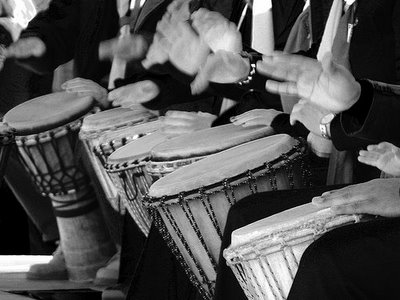How to Start Up a Drum Circle

Drums circles were originally formed for communal entertainment or religious purposes in prehistoric times, but some ancient wisdom in the activity makes it relevant even in present times, when it has become a popular activity for social, spiritual and health reasons. Drum circles consist of gatherings of people, who sit in a circle and play small drums and hand percussion instruments, and these circles can be driven by a variety of purposes.
Things Required:
– Djembe Drums
– Shakers
– Maracas
– Cowbells
– Claves
Instructions
-
1
To begin, determine the reason behind the drum circle you are aiming to set up – what does it hope to accomplish? There are a variety of reasons why people might want to get together for a drum circle. Some circles are formed simply for social reasons, while some are aimed at fulfilling spiritual purposes, such as the desire for Native American trance-inducing shamanic drumming, or for honouring the Summer Solstice. Some are merely a therapeutic activity for people with mild physical or psychological disorders, or for the elderly – drum circles can also be a great way for workers in a company or students at school to blow off some steam after hours. Finally, drum circles can also be created by groups of musicians who are looking to experiment with different types of percussion, like African tribal rhythms.
-
2
Once you have determined the purpose behind your drum circle, choose an appropriate method for conducting and managing the drum circle – you can opt for a facilitated or community drum circle. Facilitated drum circles are more organised, as these are led by a group organiser who determines the musical program or playing style for each session, approves applicants to the circle, arranges for the drumming space, and monitors the members, to make sure the desired musical effect is achieved. However, community drum circles are open to all, and do not have any set spiritual or musical aims, or a leader.
-
3
Now that you have worked out the purpose and aim behind your drum circle, it is time to purchase the most essential items – the drums. The djembe is the most popular instrument for a drum circle, as this can be used by novices and is fairly inexpensive – this is basically an African drum made of goatskin. Bongos and congas are also good for drum circles, but these tend to be more expensive. Small handheld drums like maracas, shakers, cowbells or claves are also great for beginners.
-
4
After the instruments have been bought, arrange a meeting place and timings for the drum circle. A nice wide open outdoor location, like a beach or a park, can be great on pleasant days – just make sure you obtain permission from the concerned authorities, and ensure that you have chairs, or mats for seating purposes. If you prefer an indoor venue, however, you can look into private performance venues, small theatres, and even community centres or church activity rooms. In addition to the venue, choose a time that would be suitable for most people.
-
5
Finally, after all the details have been worked out, advertise your drum circle to attract members. List the venue, timings and purpose of the drum circle, and place adverts in newspapers, or print out flyers that you can distribute or stick up in public places. Create events on social networking sites like Facebook and Twitter, and place listings in the online and print editions of Drum Circle magazine. Once you amass the number of members you were looking for, your drum circle is good to go.







